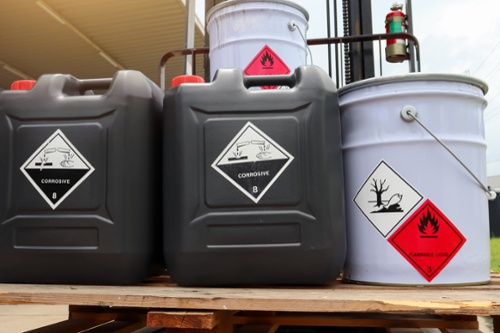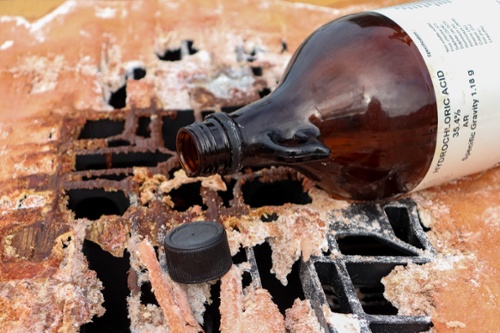During your working career, you’ve probably handled or used corrosive substances without even being aware of their dangerous chemical properties. In this post, we’ll be looking at corrosive substances in detail by highlighting the risks associated with corrosives, the difference between acids and bases, and some guidelines for the safe handling and storage of these chemicals.
What is a Corrosive Substance?
Corrosive chemicals are substances that degrade certain materials, including metal and stone, through complex chemical processes. According to the Australian Dangerous Goods (ADG) Code, corrosive substances are classified as “Class 8 - Corrosive Substances”.
The ADG Code provides us with this corrosive meaning:
“substances which, by chemical action, will cause severe damage when in contact with living tissue, or, in the case of leakage, will materially damage, or even destroy, other goods or the means of transport.”

If corrosive substances leak or spill, they can damage and destroy a range of materials.
As you can see, the meaning of 'corrosive' is a substances that damages living tissue and materials through the chemical action of corrosion.
The Australian Standard AS 1216 - Class labels for Dangerous Goods sets out the design and selection of labels and pictograms for the different classes of dangerous goods.
This standard is based on the requirements set out in the ADG code. The sign that is used to symbolise Class 8 Corrosive Substances is shown below:

What Risks Do Corrosive Substances Pose?
As a corrosive liquid or substance can degrade certain materials, such as skin, eye tissue, steel and stone, they have the potential to cause damage to people, property and the environment.
If corrosive materials touch your skin, they will immediately start to dissolve your flesh, leaving burns. When corrosive substances come in contact with the eyes of workers, they can cause serious human harm, including damage to the cornea — and even blindness.
Corrosive chemicals can also corrode vehicles and property if they leak or spill. This may include fleet vehicles carrying the chemical packages, structures that house the corrosives, or tools and equipment that comes into contact with the spilled substance.
If corrosive substances escape into the natural environment, they can quickly contaminate soil and waterways, which in turn harms wildlife, farm animals and marine life. The harsh corrosive effects can cause great harm to your people and your workplace, as well as impacting other areas and environments that have been exposed to the corrosive liquid.

An accidental release of corrosives can harm the environment, including wildlife and marine life.
What are the Main Types of Corrosive Substances?
There are 2 main types of corrosive substances: acids and bases.
1. Acids
Acids are corrosive substances that will;
- Neutralise alkalis
- Turn blue litmus paper red
- Dissolve some metals
- Taste sour
- Have a pH level less than 7
Some examples of common acids include:
- Sulfuric Acid (H2SO4)
- Hydrochloric Acid (HCl)
- Nitric Acid (HNO3)
- Citric Acid (C6H8O7)
2. Bases
Bases are corrosive substances that will:
- Neutralise acids
- Turn red litmus paper blue
- Taste bitter
- Are slippery to touch
- Have a pH level greater than 7
Some examples of common bases include:
- Sodium Hydroxide (NaOH)
- Calcium Hydroxide (Ca(OH)2)
- Sodium Carbonate (Na2CO3)
- Aluminium Hydroxide (Al[OH]3)
Requirements for Safe Corrosive Substance Storage
When storing corrosive substances in the workplace, it’s very important that you segregate acids and bases.
If acids and bases mix, they will neutralise each other — producing dangerous by-products, such as poisonous salts. In some neutralisation reactions, severe heat can evolve which can have other dangerous implications for your organisation and community.
When corrosive substances are present in the workplace, it’s vital that you store and handle them in the correct way.
The safe storage of corrosives can be achieved by:
- Ensuring that the corrosive substances are stored in compliant outdoor chemical storage containers or indoor chemical storage cabinets that meet the requirements of the Australian Standard AS 3780.
- Having a copy of the Safety Data Sheets of the corrosive substances close at hand so they can be consulted when needed.
- Displaying relevant safety signage in the areas where the corrosive substances are stored to ensure that people in the surrounding areas are aware.
- Ensuring that correct PPE such as corrosive resistance gloves and eye protection are used when handling a corrosive substance.
- Installing chemical spill kits in locations where corrosive substances are stored to ensure that spills can be cleaned up before they pose further risks.
Understand Your Corrosive Substance
As corrosive substances have a strong ability to dissolve flesh, causing severe burns to your skin and eyes, it’s crucial that you can identify and control the Class 8 chemicals present in your workplace. It’s important to take specific measures to ensure that they pose minimal risk to your staff, your business and the natural environment. If you’d like to learn how to segregate corrosive substances from incompatible classes of dangerous goods, just click on our link and you'll gain access to our free eBook.
Joining the team as a Dangerous Goods Storage Consultant, Melissa Hampton became Storemasta's Marketing Manager in late 2021. With extensive knowledge and experience in chemical compliance, Melissa is responsible for leading the Marketing team and helping shape their marketing strategy. In her spare time, you can find Melissa hiking, swimming and enjoying the great outdoors in beautiful north-west Tasmania.
